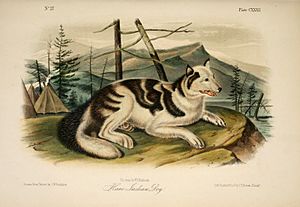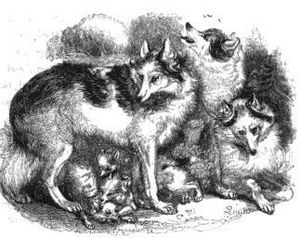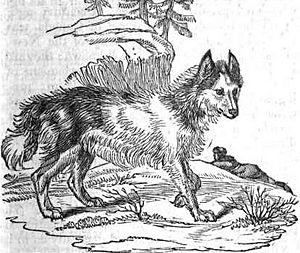Hare Indian Dog facts for kids
 |
|
| Other names | Mackenzie River dog Trap line dog C. familiaris lagopus (obsolete) |
|---|---|
| Origin |
|
| Breed status | Extinct |
| Domestic dog (Canis lupus familiaris) | |
The Hare Indian dog was an extinct type of domestic dog. It was possibly a mix of a domestic dog, coydog (a mix of coyote and dog), or even a domesticated coyote. These unique dogs were originally found and bred in northern Canada by the Hare Indians. They were used for coursing, which means chasing down animals.
This dog had the speed and some features of a coyote, but it also had the calm and friendly nature of a domestic dog. Over time, as Native American hunting methods changed, the Hare Indian dog became less useful. It either died out completely or mixed with other dog breeds in the 1800s. Some people believe that a modified version of the breed might still exist today.
Contents
What Did the Hare Indian Dog Look Like?
The Hare Indian dog was a small, thin dog. It had a small head and a long, narrow, pointed nose. Its ears stood up straight and were wide at the bottom, placed closer together than those of the Canadian Eskimo Dog. Its legs were thin and quite long. The tail was thick and bushy, and it curled up over its right hip, but not as much as the Canadian Eskimo dog's tail.
Its fur was long and straight. The main color was white with large, uneven grayish-black patches mixed with different shades of brown. The outside of its ears had short brown hair that got darker at the bottom. Inside its ears, the fur was long and white. The fur on its nose was short and white, just like on its legs, but it became longer and thicker at its feet. It also had black patches around its eyes. Like the wolves that lived in the same areas, it had long hair between its toes. This hair stuck out over the pads of its feet. Even in winter, it had tough, bare pads at the base of its toes and on its soles. In terms of size, it was somewhere between a coyote and an American red fox.
What Was Its Temperament Like?
The Hare Indian dog was known for being very playful. It easily made friends with strangers. However, it wasn't very obedient and didn't like being kept in small spaces. It showed affection by rubbing its back against people, much like a cat does.
In its home region, it was not known to bark. But puppies born in Europe learned to bark by copying other dogs. When it was hurt or scared, it would howl like a wolf. When it was curious, it made a sound that started like a growl and ended in a howl.
Sir John Richardson, a naturalist who studied these dogs in the 1820s, wrote about their behavior. He noted how playful and affectionate they were. He also mentioned that they were very fast. The Hare Indian dogs could easily outrun larger dogs that tried to chase them. He once had a young Hare Indian dog puppy that traveled 900 miles with his sledge without getting tired. This showed how strong and enduring these dogs were, even at a young age.
History of the Hare Indian Dog
Some people think this breed came from a mix of native Tahltan Bear Dogs and dogs brought to North America by Viking explorers. This is because it looked and acted a lot like dog breeds from Iceland.
However, Sir J. Richardson, who studied the breed in the 1820s before they mixed with other dogs, thought they looked very similar to coyotes. He believed they might have been a domesticated version of the wild coyote. He even said that the Hare Indian dog was to the coyote what the Eskimo dog was to the great grey wolf.
These dogs were mainly kept by the Hare Indians and other nearby tribes. These included the Bear, Mountain, Dogrib, Cree, Slavey, and Chippewa tribes. They lived in the northwestern parts of Canada and the United States. Their territory stretched from the Great Bear Lake southwest to Lake Winnipeg and Lake Superior, and west to the Mackenzie River.
The Native Americans valued these dogs as hunters. The dogs helped them chase down animals for food. Even though they weren't big enough to directly harm large animals like moose and reindeer, their small size and wide feet allowed them to chase these large animals in deep snow. They would keep the animals busy until the hunters arrived. The Hare Indian dog was too small to carry heavy loads.
The first Hare Indian dogs brought to Europe were a pair given to the Zoological Society of London. This happened after Sir John Richardson and John Franklin's expedition in 1819–1822.
The breed slowly disappeared after firearms became common. Guns made the dogs' hunting skills less necessary. The Hare Indian dog then mixed with other breeds like the Newfoundland dog, the Canadian Eskimo Dog, and other mixed-breed dogs. This mixing caused the original Hare Indian dog to lose its unique identity.
Images for kids





